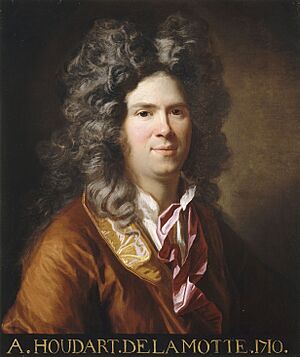Antoine Houdar de la Motte facts for kids
Quick facts for kids
Antoine Houdar de la Motte
|
|
|---|---|
 |
|
| Born | 18 January 1672 Paris |
| Died | 26 December 1731 (aged 59) Paris |
| Occupation | Choreographer, writer, librettist, playwright, poet |
Antoine Houdar de la Motte (born January 18, 1672 – died December 26, 1731) was a famous French writer. He was born and passed away in Paris, France. He wrote many different things, including plays, operas, and poems.
Antoine de la Motte started his writing career in 1693 with a comedy called Les Originaux. It wasn't very successful, which made him feel quite sad. However, he didn't give up! A few years later, he began writing stories for operas and ballets, like L'Europe galante (1697). He also wrote tragedies, which are serious plays. One of his tragedies, Inès de Castro (1723), became a huge hit at the French Theater.
Contents
A Champion of New Ideas
Antoine de la Motte was a strong supporter of "modern" ideas in a big debate called the Quarrel of the Ancients and the Moderns. This was a time when writers and thinkers argued about whether old Greek and Roman works were better than new French works. He believed that new writers could be just as good, or even better, than the ancient ones.
His Views on Writing
His book Fables nouvelles (1719) was seen as a key book for the "modern" side. He even wrote a "translation" of the Iliad, a very old Greek poem, in 1714. What's interesting is that he didn't even know Greek! He based his version on an existing translation by another writer, Anne Dacier.
He once said about his own work: "I have taken the liberty to change what I thought disagreeable in it." This shows he wasn't afraid to make changes to old stories to make them better for his time. He explained his ideas in essays like Discours sur Homère and Réflexions sur la critique. People admired his cleverness and politeness in these debates.
Later Life and Friends
In 1710, Antoine de la Motte was chosen to join the Académie Française, a very important group of French writers and scholars. Sadly, he soon lost his eyesight. He was good friends with another famous writer, Bernard le Bovier de Fontenelle, and exchanged letters with the duchess du Maine. He was known for his open mind and curious nature. His clear and excellent writing style is what made him famous.
His Creative Works
Antoine de la Motte wrote many different kinds of works. Here are some of his most notable creations.
Poetry and Fables
He wrote several collections of poems, including odes, which are poems of praise. He also wrote fables, which are short stories that teach a lesson, often using animals as characters.
- 1701: Le Premier livre de l'Iliade (a translation of the Iliad into French poetry)
- 1707: Églogue sur la naissance de Mgr le duc de Bretagne
- Odes:
* 1707: Odes avec un Discours sur la poésie en général, et sur l'ode en particulier * 1712: Le Deuil de la France * 1712: Le Souverain * 1716: Ode sur la mort de Louis le Grand * 1720: La critique
- Fables:
* 1714: Le Cygne (The Swan) * 1719: Fables nouvelles (New Fables) * 1720: L'Indien et le soleil (The Indian and the Sun)
Plays and Operas
Antoine de la Motte was very active in the theater world. He wrote many plays and librettos (the text for operas and ballets).
- 1693: Les Originaux ou l'Italien (The Originals or The Italian), a comedy
- 1697: Issé, a heroic pastoral opera
- 1697: L'Europe galante (Gallant Europe), an opera-ballet with music by André Campra
- 1699: Amadis de Grèce, a lyrical tragedy
- 1699: Marthésie, première reine des Amazones, a lyrical tragedy
- 1700: Le Triomphe des arts (The Triumph of the Arts), an opera-ballet
- 1701: Les Trois Gascons (The Three Gascons), a comedy
- 1701: Omphale, a lyrical tragedy
- 1702: La Matrone d'Éphèse (The Matron of Ephesus), a comedy
- 1703: Le Carnaval et la folie (Carnival and Folly), a comedy-ballet
- 1704: Le Port de mer (The Seaport), a comedy
- 1705: La Vénitienne (The Venetian Woman), an opera-ballet
- 1706: Alcione, a lyrical tragedy with music by Marin Marais
- 1709: Sémélé, a lyrical tragedy
- 1715: La Ceinture de Vénus (Venus's Belt), a dramatic scene
- 1721: Les Macchabées, a tragedy
- 1722: Romulus, a tragedy
- 1723: Inès de Castro, a very successful tragedy
- 1726: Œdipe (Oedipus), a tragedy
- 1730: Dalcyone, an opera
- 1731: L'Italie galante ou les contes (Gallant Italy or The Tales), a comedy
- 1735: Scanderberg, a lyrical tragedy (written with Jean-Louis-Ignace de La Serre)
- 1748: Pygmalion, a ballet (reworked by Ballot de Sauvot)
- 1753: Titon et l'Aurore (Titon and Aurora), a heroic pastoral opera
- Le Ballet des fées (The Ballet of the Fairies)
- Le Calendrier des vieillards (The Calendar of the Elders), a comedy


